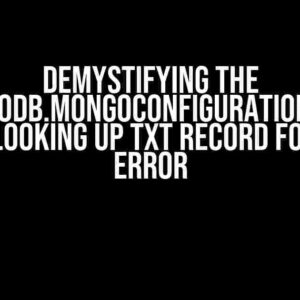Are you stuck in the loop of frustration, wondering why your delete route is not working while using MongoDB with Express? Fear not, dear developer, for we are about to embark on a thrilling adventure to solve this puzzle together!
What’s the Problem?
Before we dive into the solution, let’s first understand the issue at hand. You’ve set up your MongoDB database, created your Express routes, and written the code to delete a document. However, when you send a request to the delete route, nothing happens. The document remains stubbornly in place, taunting you with its very existence.
Symptoms of the Problem
- The delete route is not being triggered when sending a request.
- The document is not being removed from the database.
- No errors are being thrown, making it difficult to pinpoint the issue.
Step 1: Check Your MongoDB Connection
The first step in solving this mystery is to ensure that your MongoDB connection is working correctly. This might seem obvious, but it’s essential to double-check the basics.
const MongoClient = require('mongodb').MongoClient;
const url = 'mongodb://localhost:27017';
const dbName = 'mydatabase';
MongoClient.connect(url, function(err, client) {
if (err) {
console.log(err);
} else {
console.log('Connected to MongoDB');
const db = client.db(dbName);
// perform database operations
}
});
Make sure you have the correct URL, database name, and that you’re able to connect to your MongoDB instance without any errors.
Step 2: Verify Your Express Route
Next, let’s take a closer look at your Express route. Ensure that you’ve defined the route correctly and that it’s being exported properly.
const express = require('express');
const router = express.Router();
const mongoclient = require('mongodb').MongoClient;
router.delete('/:id', async (req, res) => {
const id = req.params.id;
try {
const client = await MongoClient.connect('mongodb://localhost:27017/mydatabase');
const db = client.db();
const collection = db.collection('mycollection');
const result = await collection.deleteOne({ _id: new mongodb.ObjectId(id) });
res.status(200).send(`Deleted document with id ${id}`);
} catch (err) {
console.log(err);
res.status(500).send('Error deleting document');
}
});
module.exports = router;
In this example, we’re using the `deleteOne` method to remove a document from the `mycollection` collection. Make sure you’re using the correct collection name and that the document exists in the database.
Step 3: Check Your Request
Now, let’s examine the request being sent to the delete route. Ensure that you’re sending a valid HTTP DELETE request with the correct URL and parameters.
curl -X DELETE \ http://localhost:3000/delete/1234567890abcdef12345678 \ -H 'Content-Type: application/json'
In this example, we’re sending a DELETE request to `http://localhost:3000/delete/1234567890abcdef12345678` with a Content-Type header set to `application/json`. Make sure you’re sending the correct ID and that it matches the document ID in your MongoDB database.
Step 4: Debug Your Code
If you’ve checked all the above steps and the delete route is still not working, it’s time to debug your code.
Enable Debug Logging
Enable debug logging in your MongoDB driver to see what’s happening behind the scenes.
MongoClient.connect(url, { useNewUrlParser: true, useUnifiedTopology: true }, function(err, client) {
if (err) {
console.log(err);
} else {
console.log('Connected to MongoDB');
const db = client.db(dbName);
// perform database operations
}
});
This will output detailed debug information to the console, helping you identify any issues with your MongoDB connection or operations.
Use Console Logging
Add console logging statements throughout your code to see where the execution is reaching and what values are being passed around.
router.delete('/:id', async (req, res) => {
console.log('Delete route reached');
const id = req.params.id;
console.log(`Deleting document with id ${id}`);
try {
const client = await MongoClient.connect('mongodb://localhost:27017/mydatabase');
console.log('Connected to MongoDB');
const db = client.db();
const collection = db.collection('mycollection');
console.log('Collection found');
const result = await collection.deleteOne({ _id: new mongodb.ObjectId(id) });
console.log(`Deleted document with id ${id}`);
res.status(200).send(`Deleted document with id ${id}`);
} catch (err) {
console.log(err);
res.status(500).send('Error deleting document');
}
});
This will help you pinpoint where the code is failing and what values are being passed to the deleteOne method.
Common Pitfalls
By now, you’ve probably solved the mystery of the non-working delete route. However, if you’re still stuck, here are some common pitfalls to watch out for:
- Incorrect MongoDB connection URL or database name. Double-check that your connection URL and database name are correct.
- Invalid or missing ID parameter. Ensure that you’re passing a valid ID parameter to the delete route.
- Typos in collection or database names. Verify that your collection and database names are correct and match the ones in your MongoDB database.
- Incorrect or missing MongoDB driver versions. Ensure that you have the correct version of the MongoDB driver installed.
- Failing to close the MongoDB client. Make sure to close the MongoDB client after performing database operations to avoid connection issues.
Conclusion
Voilà! You’ve solved the mystery of the non-working delete route in MongoDB with Express. By following these steps and avoiding common pitfalls, you should now be able to successfully delete documents from your MongoDB database using Express.
Remember, debugging is an essential part of the development process. Don’t be afraid to dig deep and add logging statements to your code to help you identify issues.
Happy coding, and may your delete routes be forever working!
| Tip | Description |
|---|---|
| Use a MongoDB GUI client | Use a GUI client like MongoDB Compass or Robo 3T to visualize your database and collections, making it easier to diagnose issues. |
| Enable MongoDB logging | Enable logging in your MongoDB configuration to see what’s happening on the database side. |
| Use a debugging tool | Use a debugging tool like Node.js Inspector or Visual Studio Code to step through your code and identify issues. |
Frequently Asked Question
Stuck with MongoDB and Express? Don’t worry, we’ve got you covered! Here are some frequently asked questions about deleting routes in MongoDB with Express.
Why is my delete route not working in MongoDB with Express?
This could be due to a syntax error in your route or model. Double-check your code for any typos or missing brackets. Also, make sure you’re using the correct method (e.g., ` findByIdAndRemove()` or `findOneAndRemove()`) and providing the correct parameters.
Is my MongoDB collection name correct?
Yes, it matters! Make sure you’re using the correct collection name in your model and route. The collection name is case-sensitive, so double-check for any capitalization errors.
Did I forget to import the model?
It’s easy to overlook, but make sure you’ve imported the model in your route file using `const MyModel = require(‘./models/MyModel’);` (or the equivalent ES6 import statement). Without it, your route won’t be able to interact with the model.
Do I need to handle errors and validation?
Absolutely! When deleting data, it’s crucial to handle errors and validation. Use `try`-`catch` blocks to catch any errors that might occur during the deletion process. You should also validate user input to ensure you’re deleting the correct data.
Should I use async/await or callbacks with MongoDB?
Both approaches work, but async/await is generally recommended as it makes your code easier to read and maintain. If you do choose to use callbacks, make sure you’re handling errors properly. In either case, ensure you’re waiting for the deletion operation to complete before sending a response to the client.


